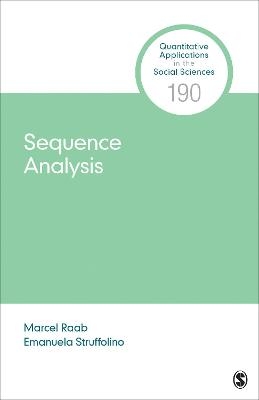
Sequence Analysis
SAGE Publications Inc (Verlag)
978-1-0718-0188-8 (ISBN)
The presentation of statistical, substantive, and theoretical foundations is enriched by examples to help the reader understand the repercussions of specific analytical choices. The extensive ancillary material supports self-learning based on real-world survey data and research questions from the field of life course research.
Data and code and a variety of additional resources to enrich the use of this book are available on an accompanying website.
Marcel Raab is Senior Researcher at the State Institute for Family Research at the University of Bamberg and Deputy Managing Director of the Journal of Family Research. Previously, he worked as a research assistant at the National Educational Panel Study and the Professorship of Demography at the University of Bamberg, as a research fellow in the research group “Demography and Inequality” at the WZB Berlin Social Science Center, and Assistant Professor for Sociology at the University of Mannheim. In 2011 he was a visiting pre-doctoral fellow at the Center for Research on Inequalities and the Life Course (CIQLE) at Yale University, New Haven. In 2014, he obtained a doctorate in sociology at the University of Bamberg with his dissertation on “Family Effects on Family Formation”. Currently, he is a member of the Advisory Board of the SAA – Sequence Analysis Association. Emanuela Struffolino is Assistant Professor of Economic Sociology at the University of Milan, Department of Social and Political Sciences. Between 2020 and 2021, she was guest Professor of Macrosociology at the Institute of Sociology at the Freie Universität Berlin and then guest Professor of Social Policy at the Humboldt-Universität zu Berlin. From 2015 to 2019 she was postdoctoral fellow at the research group “Demography and Inequality" Research Group at the WZB Berlin Social Science Center. After obtaining her PhD in Sociology at the University of Milano-Bicocca, in 2014 she worked as research fellow at the Swiss National Centre for Competence in Research “LIVES - Overcoming vulnerability: A life-course perspective" at the University of Lausanne. She is a member of the Executive Board of the SAA-Sequence Analysis Association.
Series Editor’s Introduction
Acknowledgments
Preface
About the Authors
Chapter 1. Introduction
1.1 Sequence Analysis in the Social Sciences
1.2 Organization of the Book
1.3 Software, Data, and Companion Webpage
Chapter 2: Describing and Visualizing Sequences
2.1 Basic Concepts and Terminology
2.1 Basic Concepts and Terminology
2.3 Description of Sequence Data I: The Basics
2.4 Visualization of Sequences
2.5 Description of Sequences II: Assessing Sequence
Chapter 3: Comparing Sequences
3.1 Dissimilarity Measures to Compare Sequences
3.2 Alignment Techniques
3.3 Alignment-Based Extensions of OM
3.4 Nonalignment Techniques
3.5 Comparing Dissimilarity Matrices
3.6 Comparing Sequences of Different Length
3.7 Beyond the Standard Full-Sample Pairwise Sequence Comparison
Chapter 4: Identifying Groups in Data: Analyses Based On Dissimilarities Between Sequences
4.1 Clustering Sequences to Uncover Typologies
4.2 Illustrative Application
4.3 “Construct Validity” for Typologies From Cluster Analysis to Sequences
4.4 Using Typologies as Dependent and Independent Variables in a Regression Framework
Chapter 5: Multidimensional Sequence Analysis
5.1 Accounting for Simultaneous Temporal Processes
5.2 Expanding the Alphabet: Combining Multiple Channels Into a Single Alphabet
5.3 Cross-Tabulation of Groups Identified From Different Dissimilarity Matrices
5.4 Combining Domain-Specific Dissimilarities
5.5 Multichannel Sequence Analysis
Chapter 6: Examining Group Differences Without Cluster Analysis
6.1 Comparing Within-Group Discrepancies
6.2 Measuring Associations Between Sequences and Covariates
6.3 Statistical Implicative Analysis
Chapter 7: Combining Sequence Analysis With Other Explanatory Methods
7.1 The Rationale Behind the Combination of Stochastic and Algorithmic Analytical Tools
7.2 Competing Trajectories Analysis
7.3 Sequence Analysis Multistate Model Procedure
7.4 Combining SA and (Propensity Score) Matching
Chapter 8: Conclusions
8.1 Summary of Recommendations: An Extended Checklist
8.2 Achievements, Unresolved Issues, and Ongoing Innovation
References
| Erscheinungsdatum | 06.05.2022 |
|---|---|
| Reihe/Serie | Quantitative Applications in the Social Sciences |
| Verlagsort | Thousand Oaks |
| Sprache | englisch |
| Maße | 139 x 215 mm |
| Gewicht | 250 g |
| Themenwelt | Sozialwissenschaften ► Politik / Verwaltung ► Politische Theorie |
| Sozialwissenschaften ► Soziologie ► Empirische Sozialforschung | |
| ISBN-10 | 1-0718-0188-0 / 1071801880 |
| ISBN-13 | 978-1-0718-0188-8 / 9781071801888 |
| Zustand | Neuware |
| Haben Sie eine Frage zum Produkt? |
aus dem Bereich


